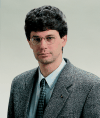 / Luiz F. Capretz / Assistant Professor
/ Luiz F. Capretz / Assistant Professor
 / Jianhua Ma / Assistant Professor
/ Jianhua Ma / Assistant Professor



 / Luiz F. Capretz / Assistant Professor
/ Luiz F. Capretz / Assistant Professor
 / Jianhua Ma / Assistant Professor
/ Jianhua Ma / Assistant Professor
The Information Systems Laboratory is concerned with the
establishment and use of sound engineering principles and
good management practice to produce quality software systems.
Our research puts software development into a new perspective
by creating new techniques, methodologies and tools to overcome
the so-called
Presently, we are involved, together with the Software Engineering Laboratory, in the development of a framework for advanced software techniques (FAST Project), spanning the whole software life cycle from requirements to maintenance. In this project, we are concerned with software reusability issues within an object-oriented approach.
As far as education is concerned, we have participated in the preparation of the courses Software Engineering I and II, and proposed innovative courses for the University of Aizu graduate curricula. The research carried out in this laboratory has allowed us to publish seven conference papers and one journal article on object-oriented design, CASE environments and telecommunications systems. I also co-authored a book on software engineering (Object-Oriented Software: Design and Maintenance).
Our research is concerned with object-oriented design methodologies for software systems. A general methodology for object-oriented design, called MOOD, has been refined, used and evaluated. MOOD is unrelated to any programming language, yet is capable of being used to design a variety of object-oriented software systems. In particular, MOOD allows the creation of a design mainly in terms of classes, objects and inheritance, and the representation of a design graphically by a set of class hierarchy diagrams, composition diagrams, object diagrams and operation diagrams.
Object-oriented design is expected to be at the forefront of new approaches to the development of complex software systems. We have investigated some general requirements for CASE tools which support object-oriented software development, taking into account a process model suitable for software reusability. The work carried out in this area has shown how these requirements can be met by a CASE tool set which supports software development within the telecommunications systems application domain.
The laboratory has been equipped with modern computers such as: powerful SUN Sparc 10 Model 51, Mac-Quadra Model 840av, NeXT, Compaq PCs, Pentium Gateway 2000, a network of nine JCC workstations, and several personal computers with accompanying peripherals. Software tools including C++ Designer, Simula and Eiffel compilers have been installed and will be used in research projects and courses taught by members of this laboratory. The library lounge has also been started up with more than a hundred books.
Refereed Journal Papers


